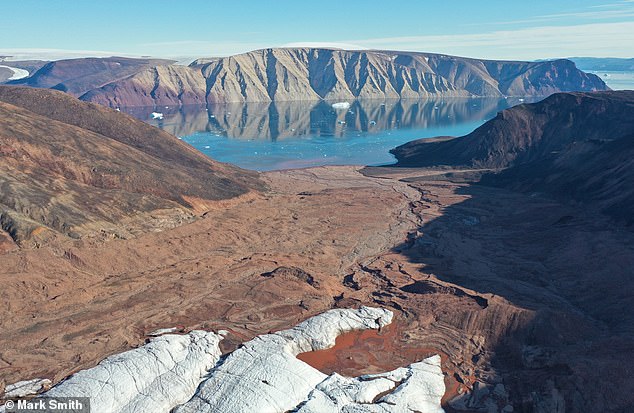According to legend, an Icelandic assassin named Erik the Red was exiled to the largest island in the world in the 10th century.
Although the island was covered in white snow as far as the eye could see, he named it “Greenland” in hopes that the name would attract settlers.
More than a thousand years later, the name may finally have some truth to it.
Scientists say Greenland is turning green because its vast ice sheet is melting and exposing the vegetation beneath.
In the last three decades, about 1.6 percent of the total Greenland ice sheet and glaciers have melted, an area larger than Wales.
An estimated 11,000 square kilometers of Greenland’s ice sheet and glaciers have melted over the past three decades, according to a major analysis of historical satellite records. Pictured is exposed land from above Sydgletscher looking into Bowdoin Fjord, in Qaanaaq, northwest Greenland.
Over three decades, Greenland has become greener as plant cover has expanded, especially in the southwest and northeast.
The new study was led by Dr Jonathan Carrivick, an earth scientist from the School of Environment at the University of Leeds.
By analyzing high-resolution satellite images, Carrivick and his colleagues estimated that 28,707 square kilometers (11,000 square miles) of the Greenland ice sheet and glaciers have melted in the past three decades.
“We had to use a collection of images spanning from the early 1980s to the early 2010s,” he told MailOnline.
“Images from a single year often have cloud cover or ephemeral snow cover, so pixel by pixel we create a free mosaic of these conditions to identify ground cover.”
The total area of ice loss (11,000 square miles) is roughly equivalent to the size of Albania or slightly smaller than the area of Belgium and slightly larger than Wales.
Carrivick said this loss affects only the Greenland ice sheet, which is often referred to as inland ice and does not encompass the entire island.
Roughly, the entire country of Greenland is about 836,000 square miles, and the ice sheet covered 679,000 square miles (about 81 percent) in the 1980s.
Now, a loss of 11,000 square miles reduces the total ice cover to 79 percent, which isn’t a huge difference in percentage, but in terms of size “it’s huge,” Dr. Carrivick said.
The total area of ice loss (11,000 square miles) is roughly equivalent to the size of Albania or slightly smaller than the area of Belgium and slightly larger than Wales. Here, exposed bushland on the Russell Glacier and proglacial area, near Kangerlussuaq, west Greenland.
Fan Glacier proglacial area, Qaanaaq, northwest Greenland, showing a braided proglacial stream
Where there was once ice and snow, there are now barren rocks, wetlands (areas saturated with water) and bushes.
Over the three decades, the amount of vegetated land increased by 33,774 square miles (87,475 square kilometers), more than doubling during the study period.
Greenland has become greener as plant cover has expanded, especially in the southwest and northeast.
There have also been high levels of ice loss in localized areas in the West, Midwest and Southeast.
Experts also found a quadrupling of wetland cover, an increase in meltwater and greater cover of fine, loose sediments.
It is well known that melting ice is the cause of rising sea levels, which could flood towns and cities this century.
But Greenland’s shift from bright white to duller green also reduces its ‘albedo’ – its ability to reflect sunlight.
Instead of highly reflective white ice, the exposed plant and rock have a lower albedo, meaning they absorb more of the sun’s energy rather than reflecting it.
This only increases the risk of the Earth warming, exacerbating climate change.
In addition to the huge decline in ice cover, experts find a doubling of total vegetation cover, a quadrupling of wetland cover, an increase in meltwater, a decrease in bare bedrock, and increased cover of fine unconsolidated sediments.
The researchers found that Greenland ice loss “is strongly associated” with the number of days with an average temperature above 0°F/0°C between the 1980s and the present.
Since the 1970s, the region has been warming at twice the global average rate, according to the team.
In Greenland, average annual air temperatures from 2007 to 2012 were 5.4°F (3°C) warmer, compared to the 1979 to 2000 average.
And researchers warn that more extreme temperatures are likely in the future, which will have “profound consequences.”
“Land cover responses to climate change must be quantified to understand the Arctic climate, manage Arctic water resources, maintain the health and livelihoods of Arctic societies, and for sustainable economic development,” they say in their article. , published in Scientific Reports.

